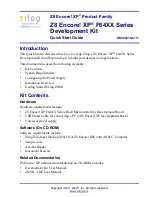
14 I
2
C (I2C)
14-12
Seiko Epson Corporation
S1C17M20/M21/M22/M23/M24/M25
TECHNICAL MANUAL (Rev. 1.0)
Data transmission
End
YES
NO
I2CnINTF.NACKIF = 1 ?
Write data to the I2CnTXD register
Wait for an interrupt request
(I2CnINTF.TBEIF = 1 or I2CnINTF.NACKIF = 1)
Figure 14.4.5.2 Slave Mode Data Transmission Flowchart
14.4.6 Data Reception in Slave Mode
A data receiving procedure in slave mode and the I2C Ch.
n
operations are shown below. Figures 14.4.6.1 and 14.4.6.2
show an operation example and a flowchart, respectively.
Data receiving procedure
1. When receiving one-byte data, write 1 to the I2C
n
CTL.TXNACK bit.
2. Wait for a START condition interrupt (I2C
n
INTF.STARTIF bit = 1).
3. Check to see if the I2C
n
INTF.TR bit = 0 (reception mode).
(Start a data sending procedure if I2C
n
INTF.TR bit = 1.)
4. Clear the I2C
n
INTF.STARTIF bit by writing 1.
5. Wait for a receive buffer full interrupt (I2C
n
INTF.RBFIF bit = 1) generated when a one-byte reception has
completed or an end of transfer interrupt (I2C
n
INTF.BYTEENDIF bit = 1).
Clear the I2C
n
INTF.BYTEENDIF bit by writing 1 after the interrupt has occurred.
6. If the next receive data is the last one, write 1 to the I2C
n
CTL.TXNACK bit to send a NACK after it is re-
ceived.
7. Read the received data from the I2C
n
RXD register.
8. Repeat Steps 5 to 7 until the end of data reception.
9. Wait for a STOP condition interrupt (I2C
n
INTF.STOPIF bit = 1) or a START condition interrupt (I2C
n
INTF.
STARTIF bit = 1).
i. Go to Step 10 when a STOP condition interrupt has occurred.
ii. Go to Step 3 when a START condition interrupt has occurred.
10. Clear the I2C
n
INTF.STOPIF bit and then terminate data receiving operations.
Data receiving operations
START condition detection and slave address check
It is the same as the data transmission in slave mode.
However, the I2C
n
INTF.TR bit is cleared to 0 and the I2C
n
INTF.TBEIF bit is not set.
If the I2C
n
MOD.GCEN bit is set to 1 (general call address response enabled), the I2C Ch.
n
starts data re-
ceiving operations when the general call address is received.
Slave mode can be operated even in SLEEP mode, it makes it possible to wake the CPU up using an inter-
rupt when an address match is detected.
Receiving the first data byte
After the valid slave address has been received, the I2C Ch.
n
sends an ACK and pulls down SCL to low un-
til 1 is written to the I2C
n
INTF.STARTIF bit. This puts the I
2
C bus into clock stretching state and the exter-
nal master into standby state. When 1 is written to the I2C
n
INTF.STARTIF bit, the I2C Ch.
n
releases SCL
and receives data sent from the external master into the shift register. After eight-bit data has been received,
the I2C Ch.
n
sends an ACK and pulls down SCL to low. The received data in the shift register is transferred
to the receive data buffer and the I2C
n
INTF.RBFIF and I2C
n
INTF.BYTEENDIF bits are both set to 1. Af-
ter that, the received data can be read out from the I2C
n
RXD register.
















































